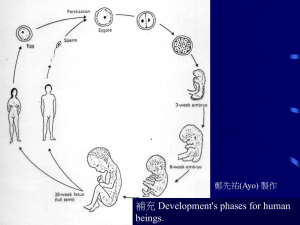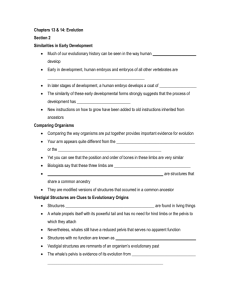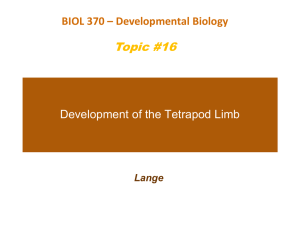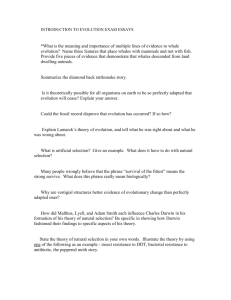Evolution of whales
advertisement
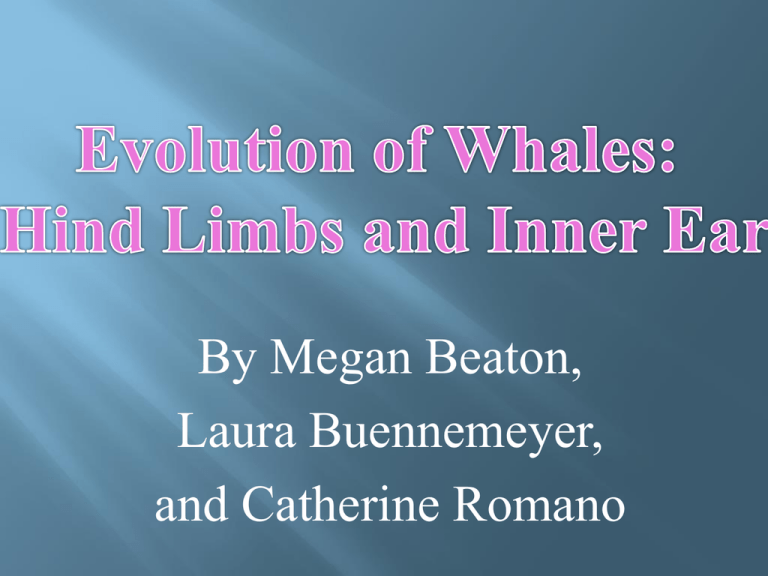
By Megan Beaton, Laura Buennemeyer, and Catherine Romano Maiacetus inuus- 49-40 million years ago Exploring the evolution of hind limbs to a vestigial structure Exploring the evolution of the inner ear Dorudon atrox- 41-33 million years ago Vestigial Structure- homologous characters in an organism that has lost all or most of their original function Vertigo- extreme dizziness, which can be caused by the ear Myosin- motor proteins found in eukaryotic tissues that are responsible for motility Myoblasts- a type of stem cell that exists in muscles Somitic myoblasts- causes the stem cells that develop in vertebrates to migrate Cetacean- mammals adapted to aquatic life, including whales, dolphins, and porpoises Echolocation- the ability to sense objects in the environments by hearing echoes from those objects Approximately 50 million years ago, the ancestors of modern day whales were four legged terrestrial mammals about the size of a raccoon Thick bone density made it easier escape predators in the water The inner ear adapted to allow the whales to move quickly under water and avoid vertigo Zygorhiza kochii Late Eocene (39-37) million years ago On land- 50 million years ago (Packistis) Aquatic- 34 million years ago (Dorudon) Total evolutionary process- approximately 15 million years total Hind limbs- started 41 million years ago; finished 34 million years ago (Gaviocetus) Inner ear- started 47 million years ago (Dalanistes) In the 5th week of gestation, the genes responsible for hind limb development are no longer expressed Initial limb outgrowth requires… Apical ectodermal ridge (AER)- signaling center for the hind limb bud regulated by Fgf8 protein Distal margin of limb bud Zone of polarizing activity (ZPA)- signaling center that maintains initial limb outgrowth Posterior connective tissue Hand2 gene- a regulator of Sonic Hedgehog (Shh) transcription and required for cell survival Hand2 is not expressed in the hind limb developing embryo after the 5th week of development Shh- mediates the signaling activity of ZPA Fgf8- protein that is coupled with AER and is not detectable or functional in the hind limb development Muscles are formed when myosin evades limb buds Myogenetic cells attracted to limb bud by signals sent out by the AER and ZPA Hind limb bud induces somitic myoblasts to migrate Myogenic cells are found in both the fore limbs and hind limbs The inner ear canal of whales is 3 times smaller than that of the human ear The evolution of the inner ear was a key point of no return Today, with the size of their ear canal, a terrestrial whale would only be able to crawl at a slow pace The ear is extremely specialized for the aquatic lifestyle Examine the relationship between size of hind limbs and whale length Explore differences with balance, feeding techniques, swimming depth, life span, speed, and location in the ocean. Study carried out by examination of different whales and different pods of whales Examine other species with similar vestigial structures, and see if the evolutionary paths are similar http://www.youtube.com/watch?v=8cn0kf8mhS4&feature=related



